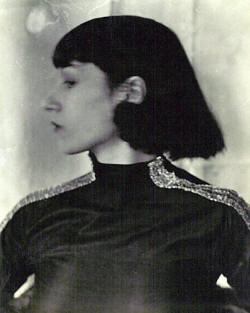

Queer Places:
Friedhof Wilmersdorf
Wilmersdorf, Charlottenburg-Wilmersdorf, Berlin, Germany
 Vera Skoronel (May 28, 1906 – March 24, 1932), born Vera Laemmel, was a Swiss-born German dancer and choreographer.
For seven years, Mary Wigman was close to her former student
Bertha Trümpy, who secured
the house for her school and was instrumental in to administration and
Wigman's early career. Trümpy later supported dancer Vera Skoronel in a
similar way, financially supporting, organizing, and administrating her school
in Berlin.
Vera Skoronel (May 28, 1906 – March 24, 1932), born Vera Laemmel, was a Swiss-born German dancer and choreographer.
For seven years, Mary Wigman was close to her former student
Bertha Trümpy, who secured
the house for her school and was instrumental in to administration and
Wigman's early career. Trümpy later supported dancer Vera Skoronel in a
similar way, financially supporting, organizing, and administrating her school
in Berlin.
Vera Laemmel was born in Zürich, the daughter of Vienna-born scientist Rudolf Lämmel (1879–1962) and Sofia (Sonja) Axelrod (1881–1917).[1] Her maternal grandfather was Russian revolutionary Pavel Axelrod, and her great-grandfather was writer Isaac Kaminer.[2] Skoronel (a name she chose for herself) trained as a dancer in Zürich with Suzanne Perrottet and Katja Wulff, and in Dresden with Mary Wigman.[3] At Wigman's school her fellow students included Gret Palucca, Hanya Holm, and propagandist and actress Leni Riefenstahl.[4][5]
In 1924, Skoronel became dance director for theatres in Oberhausen, Hamborn and Gladbeck. In the 1925-1926 season she was dance director at the theatre in Darmstadt. In 1926 she opened a school in Berlin with fellow modern dancer Bertha Trümpy.[2][6] She was a proponent of the modern style known as "abstract dance", or Ausdruckstanz.[7] Her students included dancer Ludwig Lefebre,[8] music educator Hanna Berger, diver Ilse Meudtner, and Polish artist Oda Schottmüller. She also taught members of the Sara Mildred Strauss Dancers, from New York.[9] In 1930 she and her students attende the third German Dance Congress, in Munich.[10] "Perhaps no dancer of the Weimar era was as aggressive in the pursuit of an emphatically modernist group aesthetic as Vera Skoronel," according to dance historian Karl Eric Toepfer.[11] Illustrator G. R. Halkett described her as having "one face which could not be overlooked."[12]
Skoronel died in 1932, aged 25, in Berlin, from a blood disease, possibly complicated by alcohol abuse.[2][13] Her grave is in the Wilmersdorf quarter of Berlin, and there is a small collection of her papers in the German Dance Archives in Cologne.
My published books: